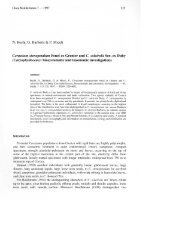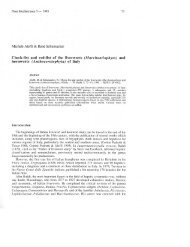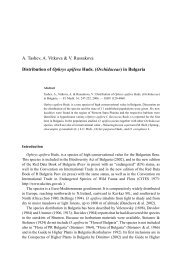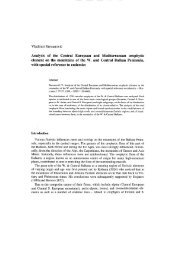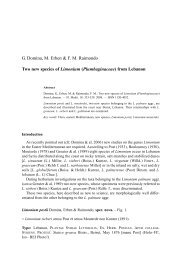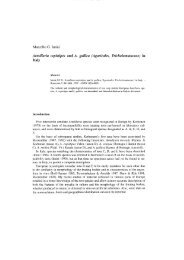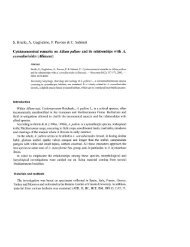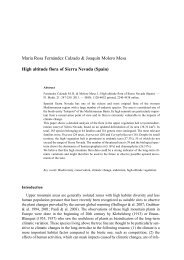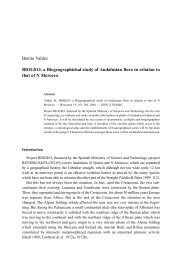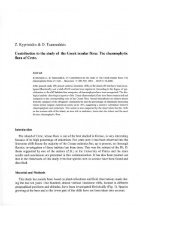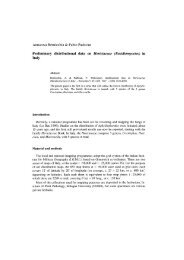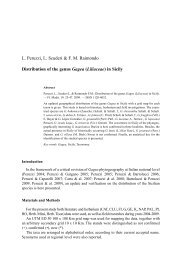Christoph Oberprieler The Systematics of Anthemis L. - Herbmedit.org
Christoph Oberprieler The Systematics of Anthemis L. - Herbmedit.org
Christoph Oberprieler The Systematics of Anthemis L. - Herbmedit.org
Create successful ePaper yourself
Turn your PDF publications into a flip-book with our unique Google optimized e-Paper software.
24 <strong>Oberprieler</strong>: <strong>Anthemis</strong> in N Africa<br />
base are found in all perennial and most annual species, they tend to be absent in <strong>Anthemis</strong><br />
boveana, A. chrysantha, and A. gharbesis <strong>of</strong> A. ser. Chrysanthae, and in most <strong>of</strong> the<br />
members <strong>of</strong> A. ser. Bourgaeinianae.<br />
Leave texture is usually herbaceous, but succulent leaves are common in species from<br />
maritime habitats (e.g. <strong>Anthemis</strong> maritima, A. secundiramea, A. chrysantha, A. mauritiana).<br />
Dimensions <strong>of</strong> leaves are variable and depend on growth conditions. However, in the<br />
<strong>Anthemis</strong> pedunculata - A. punctata group <strong>of</strong> species they may help in the determination<br />
<strong>of</strong> taxa: basalleaves in A. pedunculata are usually up to 45(-75) mm long and up to 20(-30)<br />
mm wide, those <strong>of</strong> A. punctata are conspicuously longer (up to 115 mm) and wider (up to<br />
53 mm). A. abylaea is also characterized by rather long (up to 80 mm) and wide (up to 35<br />
mm) basalleaves.<br />
<strong>The</strong> dissection <strong>of</strong> leaf blades proves to be taxonornically relevant, its degree depending<br />
on the position <strong>of</strong> the leaf on the stem. As a rule, the most basaI leaves are less strongly<br />
dissected than the lower cauline ones, and further upward leaf dissection is again gradually<br />
reduced. <strong>The</strong>refore, differences in Ieaf dissection are particularly important in the lower<br />
cauline leaves. In most N African <strong>Anthemis</strong> taxa the lower leaves are pinnatisect with<br />
primary lobes cut right to the axis, but in A. maritima subsp. bolosii and some plants <strong>of</strong><br />
A. punctata subsp. kabylica they are pinnatifid or pinnatipartite.<br />
2- to 3-pinnatisect or -pinnatipartite leaves are found in most species. <strong>The</strong> shape <strong>of</strong> ultimate<br />
leaf segments may vary within taxa from broadly triangular to narrowly elliptical or<br />
even linear, and their dimensions also varies. No clear-cut discontinuities between taxa<br />
could be observed, but some tendencies are sufficiently marked to be used as distinguishing<br />
features. For example, <strong>Anthemis</strong> pedunculata usually has 1.0-5.5 mm long and 0.3-1.8<br />
mm wide ultimate leaf segments, but those <strong>of</strong> A. punctata (1.4-9.0 mm x 0.6-2.3 mm) and<br />
A. eretica varo columnae (1.7-20.0 mm x 0.6-2.0 mm) are considerably larger. In most<br />
species, ultimate leaf segments end in a mucro <strong>of</strong> 0.1-0.3 mm length. No mucronate leaf<br />
segments were observed in some populations <strong>of</strong> A. secundiramea.<br />
Peduncles<br />
In the present study, the peduncle is defined as the distaI portion <strong>of</strong> the stem subtending<br />
a capitulum, from the most distaI leaf on this axis to the base <strong>of</strong> the involucre. While<br />
peduncle length was found to be very variable in all species examined and therefore unhelpful<br />
for the characterisation <strong>of</strong> taxa, the inflation <strong>of</strong> peduncles at maturity proved to be<br />
relevant. In the N Mrican representatives <strong>of</strong> <strong>Anthemis</strong> subg. Cota (A. austriaca) and <strong>of</strong><br />
A. sect. Hiorthia the peduncles usually remain slender or become only slightly inflated at<br />
maturity. In A. sect. <strong>Anthemis</strong> and sect. Maruta, strongly inflated peduncles are found in<br />
A. arvensis subsp. incrassata <strong>of</strong> A. ser. <strong>Anthemis</strong> and in A. chrysantha <strong>of</strong> A. ser. Chrysanthae.<br />
In A. secundiramea <strong>of</strong> A. ser. Secundirameae, this character is used to distinguish the<br />
two N African varieties <strong>of</strong> that species, varo secundiramea with and varo cossyrensis without<br />
conspicuously inflated peduncles. A further representative <strong>of</strong> this series, A. ubensis,<br />
and some populations <strong>of</strong> A. glareosa al so show incrassate peduncles. In contrast, all representatives<br />
<strong>of</strong> A. ser. Bourgaeinianae have peduncles remaining slender at maturity. In<br />
A. sect. Maruta, this character can be used to distinguish A. cotula (slender peduncles)<br />
from A: pseudocotula (inflated peduncles).



